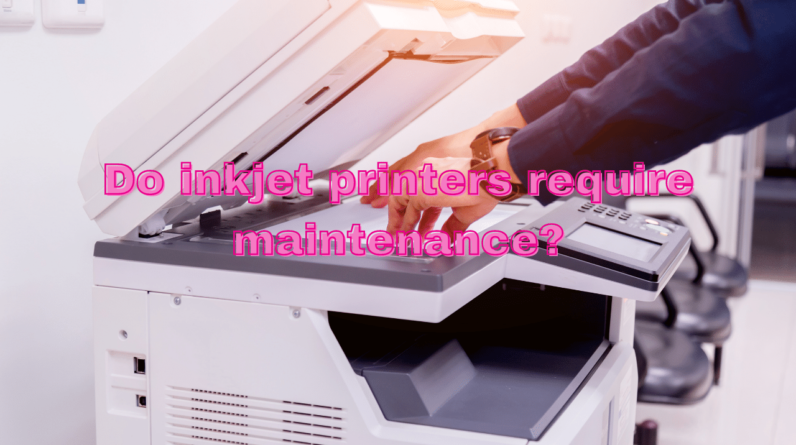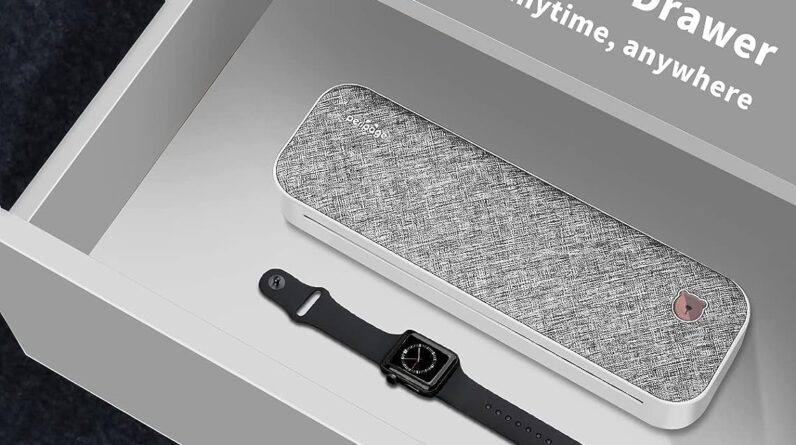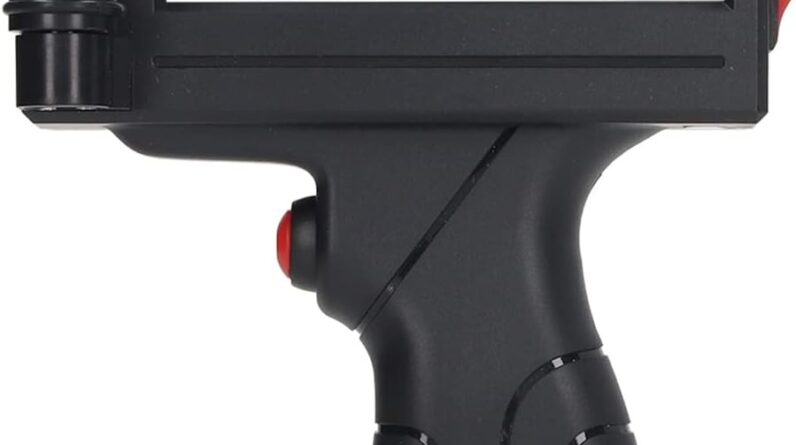
Disclaimer: This post may contain affiliate links. As an Amazon Associate, we earn from qualifying purchases.
If you own an inkjet printer, you may be wondering whether or not it requires regular maintenance. After all, with the constant advancements in technology, it’s easy to assume that these printers are virtually maintenance-free. However, it’s crucial to understand that inkjet printers do require some level of upkeep to ensure optimal performance and longevity. In this article, we will explore the importance of regular maintenance for inkjet printers and provide you with some simple yet effective tips to keep your printer running smoothly. So, let’s dive in and discover how to properly maintain your inkjet printer for high-quality printing results.
Maintenance Schedule
Cleaning the Print Head
To ensure optimal print quality, it’s important to regularly clean the print head of your inkjet printer. Over time, the print head can become clogged with dried ink or other debris, resulting in streaky or faded prints. Cleaning the print head is a simple process that can be done using the printer’s built-in cleaning function or by manually cleaning the print head with a lint-free cloth and some distilled water. By regularly cleaning the print head, you can extend the lifespan of your printer and maintain excellent print quality.
Replacing Ink Cartridges
Replacing ink cartridges is a key maintenance task for inkjet printers. When the ink levels in your cartridges run low, it’s important to replace them promptly to avoid poor print quality or potential damage to the printer. Most printers will notify you when the ink levels are low, but it’s a good idea to proactively check the ink levels and have replacement cartridges on hand. When replacing ink cartridges, be sure to follow the manufacturer’s instructions and avoid touching the electrical contacts on the cartridges. By regularly replacing ink cartridges, you can ensure consistent and vibrant prints.
Calibrating the Printer
Calibrating the printer is another important maintenance task that can help improve print quality. Printer calibration ensures that the colors and alignment of your prints are accurate and consistent. Most printers have a calibration function built into their settings or software. By following the instructions provided by your printer’s manufacturer, you can easily calibrate the printer. Regular calibration can help prevent issues such as color banding or inaccurate color representation in your prints.
Preventive Measures
Using High-Quality Ink
Using high-quality ink is essential for maintaining the performance and longevity of your inkjet printer. Inferior or low-quality ink can clog the printer’s print head, resulting in poor print quality and potential damage to the printer. It’s always best to use ink cartridges that are specifically designed for your printer model and recommended by the manufacturer. While high-quality ink cartridges may be slightly more expensive, they can significantly improve the lifespan and performance of your printer.
Using the Printer Regularly
Regular use of your inkjet printer can actually help maintain its health and performance. When a printer sits idle for extended periods of time, the ink inside the cartridges can dry up and clog the print head. By using the printer regularly, you can prevent ink from drying up and ensure that the print head remains clean and functional. If you don’t have regular printing needs, consider printing a test page or nozzle check pattern once a week to keep the ink flowing and prevent clogging.
Keeping the Printer Clean
Keeping your inkjet printer clean is crucial for its proper functioning and longevity. Dust, debris, and ink residue can accumulate inside the printer, leading to various issues such as paper jams or streaky prints. It’s important to regularly clean the exterior of the printer using a lint-free cloth and mild cleaning solution. Additionally, you should periodically clean the printer’s interior by removing dust and debris. Most printers have a cleaning function built into their settings, which can be used to remove any built-up ink or debris from the print head and other internal components.
Troubleshooting Common Issues
Print Quality Problems
One of the most common issues with inkjet printers is poor print quality. If you notice that your prints are coming out faded, streaky, or with missing colors, there are several troubleshooting steps you can take. First, check the ink levels in your cartridges and replace them if necessary. Next, clean the print head using the printer’s built-in cleaning function or by manually cleaning it with a lint-free cloth and distilled water. If the issue persists, you may need to calibrate the printer or check for any software updates that could address the problem.
Ink Leakage
Ink leakage can be a messy and frustrating issue to deal with. If you notice ink leaking from your printer, it’s important to address the problem promptly to prevent damage to the printer and other objects in its vicinity. Start by checking the ink cartridges to ensure they are properly installed and not damaged. If the cartridges are in good condition, clean the printer’s interior to remove any built-up ink or debris that may be causing the leakage. If the issue persists, it’s best to reach out to the printer manufacturer or a professional technician for assistance.
Paper Jamming
Dealing with paper jams can be a common occurrence when using an inkjet printer. If you encounter a paper jam, the first step is to carefully remove any jammed paper from the printer. It’s important to follow the manufacturer’s instructions for clearing paper jams to avoid causing any damage to the printer. Once the paper jam has been cleared, check for any loose or torn pieces of paper that may have been left behind. Keeping the paper properly aligned and using the correct type and size of paper can help prevent future paper jams.
Extended Periods of Inactivity
Cleaning and Sealing the Printer
If you plan on leaving your inkjet printer unused for an extended period of time, it’s important to properly prepare it for storage. Start by cleaning the printer’s exterior and interior to remove any dust, debris, or ink residue. Once the printer is clean, consider sealing it in a plastic bag or covering it with a dust cover to protect it from dust and other environmental factors. Avoid storing the printer in extreme temperatures, as this can affect the performance of the ink cartridges and other internal components.
Storing Ink Cartridges Properly
When storing ink cartridges for an extended period of time, proper storage is essential to maintain their performance. Remove the cartridges from the printer and carefully seal them in an airtight bag or container. Store the cartridges in a cool, dry place away from direct sunlight. It’s also a good idea to gently shake the cartridges before reinstalling them in the printer to ensure that the ink is properly distributed.
Performing Test Prints before Use
Before using your inkjet printer after an extended period of inactivity, it’s advisable to perform test prints to ensure that everything is in working order. Start by checking the ink levels in the cartridges and replacing them if necessary. Next, print a test page or nozzle check pattern to verify that all colors are printing correctly and that there are no clogs in the print head. This step will help you identify and address any potential issues before starting your printing projects.
Printer Software Updates
Keeping the Printer Driver Updated
Regularly updating the printer driver software is important to ensure compatibility and optimize performance. The printer driver communicates between your computer and the printer, so keeping it up to date can help prevent software-related issues and improve overall functionality. Most printer manufacturers provide software updates on their websites, which can be easily downloaded and installed. It’s a good practice to periodically check for driver updates and install them as they become available.
Installing Firmware Updates
In addition to updating the printer driver, it’s also important to install firmware updates for your inkjet printer. Firmware is the software that runs on the printer itself and controls its operation. Manufacturers often release firmware updates to address bugs, improve performance, and add new features. These updates can be downloaded from the manufacturer’s website and installed on the printer using a computer. By keeping the firmware up to date, you can ensure a more stable and reliable printing experience.
Replacing Parts
Replacing Worn Out Print Heads
Over time, the print heads in inkjet printers can wear out or become clogged to the point where they are no longer effective. If you notice persistent print quality issues that are not resolved by cleaning the print head, it may be necessary to replace it. Most inkjet printers have replaceable print heads that can be easily purchased and installed. However, the process of replacing the print head can vary depending on the model of your printer, so it’s best to consult the manufacturer’s instructions or seek professional assistance.
Replacing Damaged Paper Trays
If the paper tray of your inkjet printer becomes damaged or broken, it’s important to replace it to ensure smooth and reliable paper feeding. Damaged paper trays can lead to paper jams and other issues that can affect the printer’s performance. Replacement paper trays can usually be purchased directly from the printer manufacturer or through authorized retailers. When replacing the paper tray, be sure to follow the manufacturer’s instructions to ensure proper installation.
Replacing Broken Control Panels
The control panel of your inkjet printer plays a crucial role in its operation, allowing you to navigate settings, select print options, and monitor the printer’s status. If the control panel becomes broken or unresponsive, it may need to be replaced. Replacement control panels can be obtained from the printer manufacturer or authorized service providers. When replacing the control panel, it’s important to follow the manufacturer’s instructions and ensure that the replacement panel is compatible with your printer model.

This image is property of images.unsplash.com.
Cleaning the Printer Interior
Removing Dust and Debris
Over time, dust and debris can accumulate inside the printer, affecting its performance and print quality. Regularly removing dust and debris from the printer’s interior is important for maintaining its health. Start by turning off the printer and unplugging it from the power source. Gently open the printer’s cover and use a soft brush or compressed air to remove any loose dust or debris. Be careful not to touch any internal components or the print head while cleaning.
Cleaning the Paper Feed System
A clean and properly functioning paper feed system is essential for smooth and reliable printing. If you notice that the printer is having difficulty feeding paper or is experiencing frequent paper jams, it may be necessary to clean the paper feed system. Start by removing any paper from the printer and inspecting the feed rollers for any debris or residue. Use a lint-free cloth lightly moistened with water to clean the feed rollers, making sure to remove any built-up paper dust or ink residue. Allow the rollers to dry completely before reloading paper and using the printer.
Cleaning the Encoder Strip
The encoder strip is a thin, transparent strip that runs horizontally across the printer’s interior. It helps the print head to accurately position itself during the printing process. Over time, the encoder strip may accumulate dirt or ink, affecting the printer’s performance and print quality. To clean the encoder strip, turn off the printer and unplug it from the power source. Gently wipe the strip with a lint-free cloth lightly moistened with water or isopropyl alcohol, taking care not to scratch or damage the strip. Allow the strip to dry completely before reconnecting the printer.
Addressing Error Messages
Error Messages Related to Ink Cartridges
If you encounter error messages related to ink cartridges, it’s important to address them promptly to ensure proper printer functioning. Start by checking that the cartridges are correctly installed and seated in their designated slots. If the cartridges are properly installed, check for any messages indicating low ink levels and replace the cartridges if necessary. In some cases, cleaning the electrical contacts on the cartridges and in the printer may resolve the issue. If the error message persists, consult the printer’s user manual or contact the manufacturer for further assistance.
Error Messages Related to Paper Handling
Error messages related to paper handling can be frustrating, but they often have simple solutions. If you receive an error message indicating a paper jam, carefully remove any jammed paper from the printer following the manufacturer’s instructions. Check that the paper is properly inserted in the tray and aligned correctly. If the error message persists, inspect the paper path for any debris or obstructions and clean as necessary. Properly adjusting the paper guides and using the correct paper size and type can also help prevent paper-related error messages.
Error Messages Related to Software
Software-related error messages can occur if there are compatibility issues or conflicts between the printer and the computer. To troubleshoot these error messages, start by ensuring that the printer driver and firmware are up to date. If the error message persists, try uninstalling and reinstalling the printer software on your computer. It’s also a good idea to check for any software updates or patches for your operating system that may resolve the issue. If the error message continues to appear, reach out to the printer manufacturer or a professional technician for further assistance.
Performing Printer Alignment
Aligning the Print Head
Print head alignment ensures that the printed image or text is accurately placed on the paper and properly aligned. Most inkjet printers have an automatic print head alignment function that can be accessed through the printer’s settings or software. Follow the on-screen instructions to align the print head, ensuring that the printed alignment pattern is clean and free from any gaps or distortions. Regularly performing print head alignment can help improve print quality and minimize issues such as misalignment or skewing of prints.
Aligning the Paper Feed
In addition to aligning the print head, it’s also important to align the paper feed to ensure proper paper insertion and feeding. Misaligned paper can result in skewed prints or paper jams. Most printers have adjustable paper guides or trays that can be aligned to the correct paper size. Check that the guides are firmly in place and adjusted to match the width and length of the paper. Also, check that the paper is loaded correctly and aligned against the guides. Regularly verifying and adjusting the paper feed alignment can help prevent paper-related issues and ensure accurate printing.
Professional Maintenance Services
Annual Servicing and Cleaning
While regular maintenance can be done by the printer owner, it’s also beneficial to opt for professional servicing and cleaning at least once a year. Professional technicians have the expertise and tools to thoroughly clean and inspect the printer, ensuring optimal performance and longevity. During the servicing, the technician will clean the print head, inspect and clean the paper feed system, and check for any worn or damaged parts. Additionally, they may perform a calibration to ensure accurate color reproduction. Professional servicing can help identify and address any potential issues before they become major problems.
Repairing Internal Components
If your inkjet printer is experiencing more complex issues or malfunctions that cannot be resolved through regular maintenance or troubleshooting, it may require professional repair services. Internal components such as the print head, paper feed mechanism, or control panel may need to be repaired or replaced. Professional repair technicians have the necessary knowledge and expertise to diagnose and fix these issues. It’s important to seek authorized repair services to ensure that genuine parts are used and that the printer’s warranty is not voided.
Optimizing Printer Performance
In addition to regular maintenance and repairs, professional maintenance services can also optimize the performance of your inkjet printer. Professional technicians can assess the printer’s settings and configurations and make adjustments to optimize print quality and speed. They can also provide recommendations for using the printer more efficiently or help with troubleshooting specific issues. By utilizing professional maintenance services, you can ensure that your inkjet printer is operating at its best and producing high-quality prints consistently.






